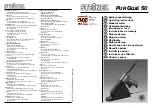
3
Framing Nailer ACHF9034 www.aeroprotools.com
Risk of bursting:
Do not adjust the pressure switch or safety valve for any reason. They have been preset at
the factory for this compressor
’s maximum pressure. Tampering with the pressure switch or the safety valve
may cause personal injury or property damage.
Risk of burns:
The pump and the manifold generate high temperatures. In order to avoid burns or other
injuries, do not touch the pump, the manifold or the transfer tube while the compressor is running. Allow the
parts to cool down before handling or servicing. Keep children away from the compressor at all times.
Risk of bursting:
Make sure the regulator is adjusted so that the compressor outlet
pressure is set lower than the maximum operating pressure of the tool. Before starting
the compressor, pull the ring on the safety valve to make sure the valve moves freely.
Drain water from tank after each use. Do not weld or repair tank. Relieve all pressure in
the hose before removing or attaching accessories.
WARNING!
Potential hazard that could result in serious injury or loss of life.
Do not allow unskilled or untrained individuals to operate the air powered tools.
Do not use the air powered tools for any task other than that it is designed to perform.
Do not use the air tools unless you have been trained to do so. Only a qualified person should use the tool.
Locate the compressor in a well-ventilated area for cooling, and must be a minimum of 12
”(31cm) away from the nearest wall.
Protect the air hose and the power cord from damage and puncture. Inspect them for weak or worn spots every week, and replace them if necessary .
Always wear hearing protection when using the air compressor. Failure to do so may result in hearing loss.
Do not carry the compressor while it is running.
Do not operate the compressor if it is not in a stable position.
Do not operate the compressor on a rooftop or in an elevated position that could allow the unit to fall or be tipped over.
Always replace a damaged gauge before operating the unit again.
CAUTION!
Potential hazard that may result in moderate injury or damage to equipment.
Always ensure that the tool has stopped before connecting to the air supply.
Do not wear watches, rings, bracelets, or loose clothing when using any air tool.
Do not overload the tool. Allow the tool to operate at its optimum speed for maximum efficiency.
Do not use a tool that is leaking air, with missing or damaged parts, or that requires repairs. Verify that all screws are
securely tightened.
For optimal safety and tool performance, inspect the tool daily in order to ensure free movement of the trigger, safety
mechanisms, and springs.
Always keep your air tools clean and lubricated. Daily lubrication is essential to avoid internal corrosion and possible failures.
Ensure the floor is not slippery and wear non-slip shoes. Floors should be kept clean can clear.
Always follow all workshop safety rules, regulations, and conditions when using the tools.
Carry the tool by the handle only. Do not carry the tools with a finger on the trigger. Do not carry the tool by the hose,
magazine or any other parts.
Do not use the tool near or below freezing temperatures, as doing so may cause tool failure.
Do not store the tool in a freezing environment to prevent ice formation on the operating valves of the tool, as doing so may cause tool failure.
Handling and storage of oil: Use with adequate ventilation. Avoid contact of oil with eyes, skin, and clothing. Avoid breathing spray or
mist. Store in a tightly closed container in a cool, dry, well-ventilated area free from incompatible substances.
CAUTION!
Potential hazard that may result in moderate injury or damage to equipment.
Disconnect tool from the air supply and turn off the compressor before performing any maintenance, or
changing accessories, when the tool is not in use, when it is being handed to another person, and when






























